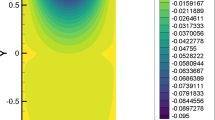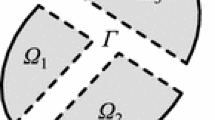Abstract
A method of parallel solution of the steady creep and heat-conduction problems is proposed, on the basis of decomposition of the structure and approximate nonlinear models of the deformation of the structural components. An ANSYS program implements this method. Calculations confirm the effectiveness of the proposed algorithm.
Similar content being viewed by others
References
Bogachev, K.Yu., Osnovy parallel’nogo programmirovaniya (Principles of Parallel Programming), Moscow: Binom, Laboratoriya Znanii, 2003.
Yagawa, G., Yoshoka, A., and Soneda, S., A Parallel Finite Element method with a Supercomputer Network, Comp. Struct., 1993, vol. 47, no. 3, pp. 407–418.
Le Tallec, P., De Roeck, Y.H., and Vidrscu, M., Domain Decomposition Methods for Large Linearly Elliptic Three Dimensional Problems, J. Comp Appl. Math., 1991, vol. 34, pp. 93–117.
Utku, S., Melosh, R., Islam, M., and Salama, M., On Nonlinear Finite Element Analysis in Single-, Multi-, Parallel Processors, Comp. Struct., 2007, vol. 15, no. 1, pp. 39–47.
Le Tallec, P., Domain Decomposition Methods in Computational Mechanics, Comp. Mechan. Adv., 1994, no. 1(2), pp. 121–220.
Ast, M., Fischer, R., Labarta, J., and Manz, H., Run-Time Parallelization of Large FEM Analyses with PERMAS, Adv. Eng. Software, 1998, vol. 29(3–6), pp. 241–248.
Chiang, K.N. and Fulton, R.E., Concepts and Implementation of Parallel Finite Element Analysis, Comp. Struct., 1990, vol. 36(6), pp. 1039–1045.
Storaasli, O.O. and Bergan, P., Nonlinear Substructuring Method for Concurrent Processing Computers, AIA J., 1987, vol. 25, pp. 871–876.
Kuenings, R., Parallel Finite Element Algorithms Applied to Computational Rheology, Comp. Chem. Eng., 1995, vol. 19, nos. 6/7, pp. 647–669.
Klebanov, Ya.M. and Samarin, Yu.P., Power-Dissipation Surfaces in Force and Velocity Spaces during the Steady Creep of Nonuniform and Anisotropic Bodies, Izv. Ross. Akad. Nauk, Mekhan. Tverd. Tela, 1997, no. 6, pp. 121–125.
Klebanov, Ya.M. and Davydov, A.N., Generalized-Model Method in Calculating the Steady Creep of Structures, Molodaya nauka: Tez. dokl. mezhdunar. nauch.-tekhn. konf. Ch. 1. Naberezhnye Chelny (Young Scientists: Proceedings of International Conference, vol. 1, Shipping Structures), 1996.
Klebanov, I.M. and Davydov, A.N., A Parallel Computational Method in Steady Power-Law Creep, Int. J. Numerical Methods Eng., 2001, vol. 50, pp. 1825–1840.
Klebanov, Ya.M. and Davydov, A.N., Parallel Solution of Nonlinear Problems with an Arbitrary Deformation Diagram, Vestn. SamGTU, Ser. Tekh. Nauki, 2000, issue 10, pp. 19–28.
Termoprochnost’ detalei mashin (Thermal Strength of Machine Parts), Birger, I.A. and Shor, B.F., Eds., Moscow: Mashinostroenie, 1975.
Il’yushin, A.A., Mekhanika sploshnoi sredy (Continuum Mechanics), Moscow: Mashinostroenie, 1975.
Ranteskii, B. and Savchuk, A., Temperature Effects in Plasticity. Part 1. Coupled Theory, Mekhanika, novoe v zarubezhnoi nauke. Vyp. 18. Problemy teorii plastichnosti i polzuchesti (Mechanics: New Developments Abroad, Issue 18, Plasticity and Creep Theory), Moscow: Mir, 1979, pp. 203–220.
Klebanov, Ya.M., Adeyanov, I.E., and Davydov, A.N., Model of Coupled Nonsteady-Creep, Heat-Conduction, and Damage Processes, Vestn. SamGTU, Ser. Fiz.-Mat. Nauki, 2003, issue 19, pp. 64–69.
Muchnik, G.F. and Rubashov, I.B., Metody teorii teploobmena, Ch. 1. Teploprovodnost’ (Methods of Heat-Transfer Theory, vol. 1, Heat Conduction), Moscow: Vysshaya Shkola, 1970.
Kachanov, L.M., Teoriya polzuchesti (Creep Theory), Moscow: Fizmatgiz, 1960.
Boyle, J.T. and Spence, J., Stress Analysis for Creep, London: Butterworths, 1983.
Nazarov, G.I., Sushkin, V.V., and Dmitrievskaya, L.V., Konstruktsionnye plastmassy (Structural Plastics), Moscow: Mashinostroenie, 1973.
Author information
Authors and Affiliations
Additional information
Original Russian Text © Ya.M. Klebanov, V.G. Fokin, 2008, published in Vestnik Mashinostroeniya, 2008, No. 6, pp. 21–25.
About this article
Cite this article
Klebanov, Y.M., Fokin, V.G. Parallel solution of creep and heat-conduction problems by means of nonlinear generalized models. Russ. Engin. Res. 28, 537–542 (2008). https://doi.org/10.3103/S1068798X08060051
Published:
Issue Date:
DOI: https://doi.org/10.3103/S1068798X08060051




